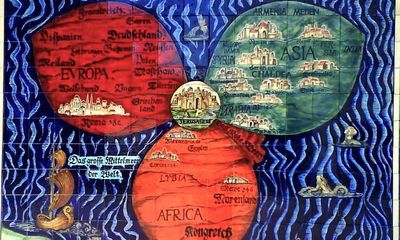Global religions: Where is the Christian map moving?

Christmas is the holiday most celebrated by Christians around the world. For most Americans, Christmas now is behind us — but millions of adherents, especially Orthodox Christians, will keep celebrating into January. From its birth in the Middle East, Christianity has circled the globe.
Do you know where most Christians live today?
Do you know how the Christian map has changed through history?
Over the past 2,000 years, Christianity spread outward from Jerusalem and eventually—for more than 1,000 years—the greatest centers of Christian scholarship and leadership were in northern Africa and in the vast sweep of Asia that stretches toward India.
If you care to read more about that period, look for historian Philip Jenkins’ fascinating book, The Lost History of Christianity. For his book cover, Jenkins’ selected one of the medieval maps of the “Christian world ”— shaped like a three-petaled flower with Jerusalem at the center.
How the map has shifted! To see this at a glance, click here to look at the new Pew map of global religious concentrations. Compare the Pew map with the three-petaled flower, shown above. You will notice that two of the historic petals of Christian strength now appear green on the Pew map — meaning that northern Africa and the Asian regions east of Jerusalem are largely homelands of Islam today. Now, the world’s biggest Christian communities thrive in regions unimaginable to medieval map makers.
Here is what Pew tells us about worldwide Christianity:
Now, about one in three people in the world are Christians, according to the just-released Pew report. Catholics are the largest single group, about half of the 2.2 billion Christians in the world. More than a third (37 percent) are Protestant, 12 percent are part of various Orthodox churches, and 1 percent are Mormons, Christian Scientists, Jehovah’s Witnesses and others.
Now, almost all Christians (99 percent) live outside the Middle East. In sheer numbers Europe has the most: almost 560 million Christians. That’s about 75 percent of the total European population. The Caribbean and Latin America are next, with 90 percent of its estimated population of 590 million identifying as Christian.
Sub-Saharan Africa is next, with well over 500 million Christians—about 63 percent of the region’s total population. But that African wave of Christianity actually is further to the south than what Jenkins describes from 1,000 years ago. Then, Egypt and the lands surrounding Egypt in northern Africa were great centers of Christianity. Now, Christian concentrations in Africa are much farther afield.
The Asia-Pacific region is ranked fourth, with almost 290 million Christians. But this is only 7 percent of the total population of that region.
North America ranks fifth in sheer numbers, with almost as many Christians as the Asia-Pacific region. However, these numbers account for more than three-quarters of that region’s total population.
The region that gave birth to Christianity has only 12.7 million Christians today. This figure combines the Middle East and North Africa. That’s less than 4 percent of the total population living in this region.
Does this historic movement in the Christian map surprise you?
What do these shifts mean for world politics, security and culture?
Do you think the Christian map could keep changing?
Wayne Baker is a sociologist on the faculty of the University of Michigan Ross School of Business. Baker blogs daily at Our Values and can be reached at ourvaluesproject@gmail.com or on Facebook.

